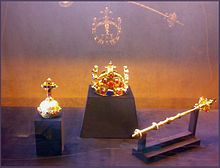- Czech Crown Jewels
-
The Czech Crown Jewels include the Crown of Saint Wenceslas (Svatováclavská koruna), the royal orb and sceptre, the coronation vestments of the Bohemian kings, the gold reliquary cross, and St. Wenceslas' sword. The crown was made for the coronation of Charles IV in 1347, making it the fourth oldest in Europe.[1]
Contents
Description
The crown is named and dedicated after the Duke St. Wenceslaus of the Přemyslids dynasty of Bohemia. The crown has an unusual design, with vertical fleurs-de-lis standing at the front, back and sides. Made from gold and a set of precious rubies, sapphires, emeralds and pearls, the 22-carat gold crown weighes 2.475g. It was originally held in Karlstejn Castle, designed in the 14th century by Matthias of Arras. Since 1867 it has been stored in St. Vitus Cathedral of Prague Castle.
After 1918 and the establishment of the Czechoslovak Republic the Coronation Jewels ceased to serve their original function, but remained important as symbols of national independence and statehood. According to the ancient tradition and regulations laid down by Charles the Fourth in the 14th century, the jewels are exhibited only to mark special occasions (last time in 2008). But this occurs only on quite exceptional occasions. In the twentieth century there were nine such moments in history. The President of the Republic has the exclusive right to decide on the display of the Crown Jewels.
The door to Crown Jewels chamber, and likewise the iron safe, has seven locks and there are seven holders of the keys: the President of the Republic, the Prime Minister, the Prague Archbishop, the Chairman of the House of Deputies, the Chairman of the Senate, the Dean of the Metropolitan Chapter of St. Vitus Cathedral and the Mayor of Prague, who must all convene to facilitate opening the impenetrable door and coffer.
An ancient Czech legend says that any usurper who places the crown on his head is doomed to die within a year. In the eyes of some this was confirmed during World War II when Reinhard Heydrich, the Nazi governor of the puppet Protectorate of Bohemia and Moravia secretly wore them believing himself to be a great king, and was assassinated less than a year later by the Czech underground.
List of crowned czech kings and queens
King Coronation date Vratislav I. (1061–1092, king from 1085) - Svatava Polská
20. 4. 1085, Mohuč; 15. 6. 1086
15. 6. 1086
Vladislav I. (1140–1172, král od r. 1158) - Judita Durynská (?)
11. 1. 1158, Řezno; 8. 9. 1158, Milán
1158 (?)
Přemysl Otakar I. (1192–1193, 1197–1230, král od r. 1198) 8. 9. 1198, Boppard; 24. 8. 1203, Merseburg Václav I. (1230–1253) - Kunhuta Štaufská
6. 2. 1228
6. 2. 1228
Přemysl Otakar II. (1253–1278) - Kunhuta Uherská
25. 12. 1261
25. 12. 1261
Václav II. (1283–1305) - Guta Habsburská
- Eliška Rejčka
2. 6. 1297
2. 6. 1297
26. 5. 1303Jan Lucemburský (1310–1346) - Eliška Přemyslovna
- Beatrix Bourbonská
7. 2. 1311
7. 2. 1311
18. 5. 1337Kings and queens crowned by Crown of Saint Wenceslas (and other crown jewels):
King Coronation dateDatum korunovace Karel IV. (1346–1378) - Blanka z Valois
- Anna Falcká
- Anna Svídnická
- Alžběta Pomořanská
2. 9. 1347
2. 9. 1347
1. 9. 1349
28. 7. 1353
18. 6. 1363Václav IV. (1378–1419) - Johanna Bavorská
- Žofie Bavorská
15. 6. 1363
17. 11. 1370
13. 3. 1400Zikmund Lucemburský (1419–1421, 1436–1437) - Barbora Cellská
28. 7. 1420
11. 2. 1437
Albrecht Habsburský (1438–1439) 29. 6. 1438 Ladislav Pohrobek (1453–1457) 28. 10. 1453 Jiří z Poděbrad (1458–1471) 2. 4. 1458 Vladislav II. Jagellonský (1471–1516) 22. 8. 1471 Ludvík Jagellonský (1516–1526) - Marie Habsburská
11. 3. 1509
1. 6. 1522
Ferdinand I. Habsburský (1526–1564) - Anna Jagellonská
24. 2. 1526
24. 2. 1526
Maxmilián II. (1564–1576) - Marie Španělská
20. 11. 1562
20. 11. 1562
Rudolf II. (1576–1611) 25. 9. 1575 Matyáš II. (1576–1619) - Anna Tyrolská
11. 5. 1611
10. 1. 1616
Fridrich Falcký (1619–1620) - Alžběta Stuartovna
4. 11. 1619
4. 11. 1619
Ferdinand II. (1619–1637) - Eleonora Gonzaga
29. 6. 1617
21. 11. 1627
Ferdinand III. (1637–1657) - Eleonora Gonzaga
24. 11. 1627
11. 9. 1656
Ferdinand IV. (vládu nenastoupil) 5. 8. 1646 Leopold I. (1657–1705) 14. 11. 1656 Karel VI. (1711–1740) - Alžběta Kristýna Brunšvická
5. 9. 1723
8. 9. 1723
Marie Terezie (1740–1780) 12. 5. 1743 Leopold II. (1790–1792) - Marie Luisa Španělská
6. 9. 1791
12. 9. 1791
František I. (1792–1835) - Marie Terezie Sicilská
9. 8. 1792
11. 8. 1792
Ferdinand V. (1835–1848) - Marie Anna Savojská
12. 9. 1836
12. 9. 1836
See also
References
- ^ Andrew Lawrence Roberts, From Good King Wenceslas to the Good Soldier Švejk: a dictionary of Czech Popular Culture, pg. 83, Central European University Press (2005), ISBN 963-7326-26-X
External links
Crown jewels by country Austria · Brazil · Czech Republic · Denmark · France · Germany (Bavaria · Prussia) · Greece · Hungary · Holy Roman Empire · Iran · Ireland · Japan · Malaysia · Madagascar · Netherlands · Nigeria · Norway · Poland · Romania · Russia · Serbia · Spain · Sweden · Thailand · United Kingdom (Scotland · Wales)Former or historical sovereign states shown in italics Categories:- Crowns
- Crown jewels
- National symbols of Austria-Hungary
Wikimedia Foundation. 2010.

